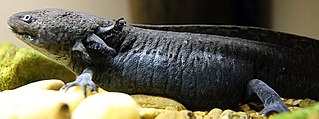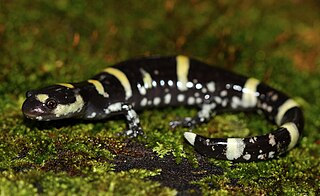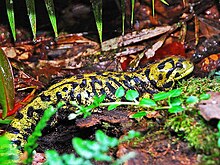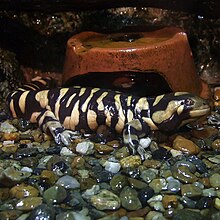
Salamanders are a group of amphibians typically characterized by their lizard-like appearance, with slender bodies, blunt snouts, short limbs projecting at right angles to the body, and the presence of a tail in both larvae and adults. All ten extant salamander families are grouped together under the order Urodela from the group Caudata. Urodela is a scientific Latin term based on the Ancient Greek οὐρά δήλη: ourà dēlē "conspicuous tail". Caudata is the Latin for "tailed ones", from cauda: "tail".

The axolotl is a paedomorphic salamander closely related to the tiger salamander. It is unusual among amphibians in that it reaches adulthood without undergoing metamorphosis. Instead of taking to the land, adults remain aquatic and gilled. The species was originally found in several lakes underlying what is now Mexico City, such as Lake Xochimilco and Lake Chalco. These lakes were drained by Spanish settlers after the conquest of the Aztec Empire, leading to the destruction of much of the axolotl's natural habitat.

The mole salamanders are a group of advanced salamanders endemic to North America. The group has become famous due to the presence of the axolotl, widely used in research due to its paedomorphosis, and the tiger salamander which is the official amphibian of many US states, and often sold as a pet.

The tiger salamander is a species of mole salamander and one of the largest terrestrial salamanders in North America.

The spotted salamander or yellow-spotted salamander is a mole salamander common in eastern United States and Canada. It is the state amphibian of Ohio and South Carolina. The species ranges from Nova Scotia, to Lake Superior, to southern Georgia and Texas. Its embryos have been found to have symbiotic algae living in and around them, the only known example of vertebrate cells hosting an endosymbiont microbe.

The California tiger salamander is a vulnerable amphibian native to California. It is a mole salamander. Previously considered to be a subspecies of the tiger salamander, the California tiger salamander was recently designated a separate species again. The California tiger salamander distinct population segment (DPS) in Sonoma County and the Santa Barbara County DPS are listed as federally endangered, while the Central California DPS is listed as federally threatened. The Sonoma County, south San Joaquin, and the Santa Barbara County DPS have diverged from the rest of the California tiger salamander populations for over one million years, since the Pleistocene and they may warrant status as separate species.

The ringed salamander is a species of mole salamander native to hardwood and mixed hardwood-pine forested areas in and around the Ozark Plateau and Ouachita Mountains of Arkansas, Oklahoma, and Missouri. This species of salamander has slander body, small head, and long tail. They are usually found to have various dorsal color from dark gray to dark brown. Various close relatives are found such as marbled salamander and spotted salamander. This species of salamander has cannibal behavior especially those in large body size.

The long-toed salamander is a mole salamander in the family Ambystomatidae. This species, typically 4.1–8.9 cm (1.6–3.5 in) long when mature, is characterized by its mottled black, brown, and yellow pigmentation, and its long outer fourth toe on the hind limbs. Analysis of fossil records, genetics, and biogeography suggest A. macrodactylum and A. laterale are descended from a common ancestor that gained access to the western Cordillera with the loss of the mid-continental seaway toward the Paleocene.

Taylor's salamander is a species of salamander found only in Laguna Alchichica, a high-altitude crater lake to the southwest of Perote, Mexico. It was first described in 1982 but had been known to science prior to that. It is a neotenic salamander, breeding while still in the larval state and not undergoing metamorphosis. The lake in which it lives is becoming increasingly saline and less suitable for the salamander, which is declining in numbers. The International Union for Conservation of Nature (IUCN) has rated it as being "critically endangered".

The Lake Patzcuaro salamander, locally known as achoque, is a paedomorphic species of salamander found exclusively in Lake Pátzcuaro, a high-altitude lake in the Mexican state of Michoacán. First described in 1870 by Alfredo Dugès, the species is named in honor of the French herpetologist Auguste Duméril. However, the salamander has been used as a food source and an ingredient in traditional medicines by the Purépecha people since the Pre-Columbian era. Ambystoma dumerilii are neotenic, meaning they retain their larval characteristics throughout their entire life. This results in adults that have long, heavily filamented external gills, gill slits lined with tooth-like gill rakers, and caudal fins. When stressed, Ambystoma dumerilii can undergo an incomplete metamorphosis, though this is process significantly decreases their lifespan and is often fatal.
The Puerto Hondo stream salamander or Michoacan stream salamander is a mole salamander from the Trans-Mexican Volcanic Belt within the Mexican state of Michoacán.

The yellow-peppered salamander also known as the salamandra de Champala and the yellow-headed salamander, is a species of mole salamander native to areas at an elevation of 4900 ft around Santa Cruz, Rancho Malveste and Tapalpa in Jalisco, Mexico.

The small-mouth salamander is a species of mole salamander found in the central United States, from the Great Lakes region in Michigan to Nebraska, south to Texas, and east to Tennessee, with a population in Canada, in Pelee, Ontario. It is sometimes referred to as the Texas salamander, porphyry salamander, or the narrow-mouthed salamander. The Kelley's Island salamander was synonymized with A. texanum in 1995.

Ambystoma talpoideum, the mole salamander, is a species of salamander found in much of the eastern and central United States, from Florida to Texas, north to Illinois, east to Kentucky, with isolated populations in Virginia and Indiana. Older sources often refer to this species as the tadpole salamander because some individuals remain in a neotenic state. This salamander lives among the leaf litter on the forest floor, migrating to ponds to breed.

Ambystoma rivulare is a species of mole salamander in the family Ambystomatidae. Typically gains a lot of population distribution in the Trans-Mexican Volcanic Belt around central Mexico City. Found in various small or medium-sized ponds and lakes that have large and wide range of food options, all within a distance of at least 2 km. It is endemic to Mexico. Its natural habitats are subtropical or tropical moist montane forests and rivers. It is threatened by habitat loss. The larvae, who continue to prey on the same organisms as they grow, prey mainly on ostracods as well as some gastropods and assorted other prey with limited diversity. Ambystoma rivulare continue to live in the river they hatch in post-metamorphosis. Research on the Michoacan Stream Salamander has important implications for the conservation and persistence of these salamanders. The lack of variety in the A. rivulare diet puts them in a precarious situation should environmental factors endanger the ostracod population in their habitat. Further, a study done at the University of Sao Paulo on the diet of A. rivulare shows no relationship between size and the salamander's diet, suggesting a lack of larger prey for the bigger salamanders to eat.

The Sacramento Mountain salamander is a species of salamander in the family Plethodontidae. It is endemic to mountainous regions of New Mexico in the United States. Its natural habitat is temperate forests where it is threatened by habitat loss.

The Blue Ridge two-lined salamander is a species of salamander in the family Plethodontidae, endemic to the United States. This species is found in the southern Appalachian Mountains, mostly south of Virginia. To the north is a similar salamander, Eurycea bislineata, or the northern two-lined salamander. Its genus, Eurycea contains 33 species and includes taxa that have either a metamorphic life cycle or larval-form paedomorphosis. In species that metamorphose, there can be within-and among-population variation in larval life-history characteristics, e.g., duration of the larval period and size at metamorphosis. Intraspecific geographic variation in species of Eurycea has been attributed to several factors: temperature, stream order and productivity of the larval habitat.
James Donald Anderson, Jr. was an American herpetologist with the American Museum of Natural History and professor of zoology at Rutgers University who did extensive fieldwork studying Ambystoma and other salamander species in Mexico. He was born in Newark, New Jersey, on August 16, 1930, and grew up in the nearby town of Belleville. He attended the Rutgers University–Newark College of Arts and Sciences and earned a B.A. in zoology in 1954. From 1954 to 1960 he was a graduate student at UC Berkeley, working under Robert C. Stebbins. Anderson returned to Rutgers University–Newark as a faculty member in 1960, and died from injuries sustained in a car accident on November 20, 1976. Anderson's salamander is named after him.


















